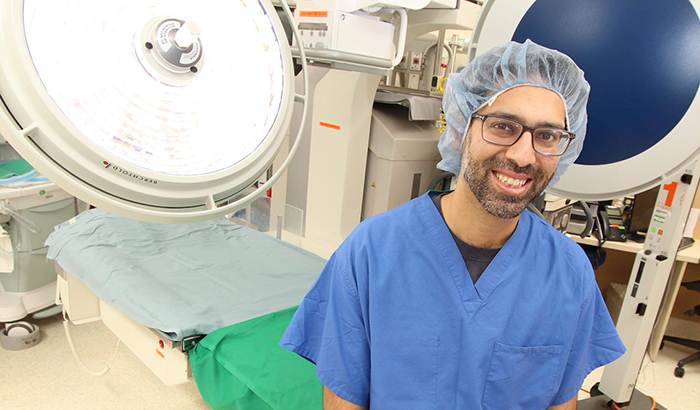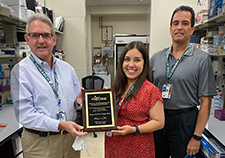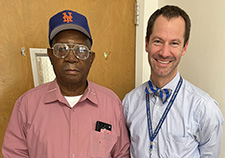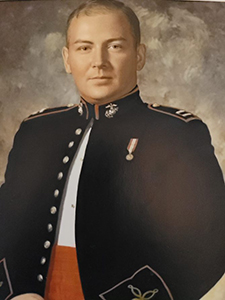Office of Research & Development |
 |


Dr. Mohummad Minhaj Siddiqui is a major supporter of active surveillance, which calls for a series of monitoring procedures for men with low-risk prostate cancer, instead of immediate surgery or radiation. (Photo by Mitch Mirkin)
February 4, 2022
By Mike Richman
VA Research Communications
Prostate cancer is the most common cancer in American men, with one in eight being diagnosed with the disease at some point in their lives. At the same time, 90% of men who have prostate cancer will live on because the cancer remains localized and does not spread to other parts of the body. They will ultimately die of something else.
This is defined as low-risk prostate cancer.
In the case of a 65-year-old patient with this diagnosis, for example, what would be the best medical approach?
Dr. Mohummad Minhaj Siddiqui, the director of urology for the VA Maryland Health Care System, is a major advocate of active surveillance. That means instead of opting for surgery to remove the prostate or radiation to zap the cancerous cells, properly selected patients would follow a series of monitoring procedures. They include blood tests to check the PSA (prostate specific antigen) score; MRIs (magnetic resonance imaging); digital rectal exams; and biopsies in which doctors examine prostate cells for signs of disease progression. Plus, new genomic tests are available to help doctors prescribe the best-targeted medication.
While active surveillance sounds like a logical approach for men with low-risk prostate cancer, especially given that prostate removal and radiotherapy can lead to urinary, bowel, and sexual dysfunction, convincing patients to buy into it can be a challenge all its own.
"Fundamentally, many people are uncomfortable with the thought that they've been told they have cancer, but that they're not going to do anything about it."
“Fundamentally, many people are uncomfortable with the thought that they’ve been told they have cancer, but that they’re not going to do anything about it,” says Siddiqui, who is also an associate professor of surgery at the University of Maryland School of Medicine. “It takes a lot of explanation and coaching to make someone comfortable with it. Some people will never be comfortable with it. Active surveillance is not the same as ignoring the cancer or walking away from it. It’s a very engaged proactive process where you are closely monitoring the person.”
Over the past 15 years, active surveillance has become a popular practice in the medical community in cases of low-risk prostate cancer. Many men in that grouping have a PSA score of less than 10 and a Gleason score of six or less. A PSA score is like an alert that someone needs to be checked out. A Gleason score, which is calculated through a biopsy, predicts the aggressiveness of prostate cancer.

VA researchers using AI to decide best treatment for rectal cancer

VA center training the next generation of researchers in blood clots and inflammation

AI to Maximize Treatment for Veterans with Head and Neck Cancer

Veterans help find new cancer treatments
Active surveillance is often recommended as a first-line treatment in various guidelines to avoid overtreatment and complications with surgery and radiation. The National Comprehensive Cancer Network, a non-profit alliance of 31 leading cancer centers devoted to patient care, research, and education, recently reversed itself with new guideline language restoring active surveillance as a preferred approach for most men with low-risk prostate cancer.
Yet, almost half of men diagnosed with low-risk prostate cancer opt for immediate treatment, a rate much higher in the U.S. than in other parts of the world, according to Siddiqui. In addition to the skittishness patients may feel about living with the cancer, financial and legal pressures sometimes influence clinicians in the United States to recommend surgery, radiation, or some other form of treatment, he says.
“There’s a mix of things that come into play,” Siddiqui says. “It’s important to remember that the practice of medicine is evolving, and even though today we are strongly advocating for active surveillance, that doesn’t mean that was the practice 5 to 10 years ago. The field is trying to push the envelope a little bit on who you can do [active surveillance] on, but that’s not the way it was before. Before, you were typically trying to be more conservative. So someone who’s been practicing medicine for 20 years and may not be in an academic environment may not be day-to-day in adapting to the newest changes.
“Not everyone has access to all of the new technologies and innovations that you have access to at a university, like advanced MRIs and genomic testing,” he adds. “So it’s easy for a university to say you should do active surveillance, you should do this, you should do that. But for someone in a rural part of the state where there’s an old MRI machine, or the nearest MRI is an hour and a half away from the patient, none of this may be relatable to them. They may not have access to all of the tools you would safely need to monitor these patients.”
Prostate cancer, the second-leading cause of cancer deaths among men, is most common in men age 65 and older and is a major medical issue in the Veteran population, which is about 90% male. Many Veterans also fall in the age range in which prostate cancer peaks.
Cancer of the prostate, a walnut-sized gland that is part of the male reproductive system, is usually found in its early stages, typically in PSA screenings. Tumors often grow slowly and may take many years to become large enough to be detectable and even longer to spread beyond the prostate. But some cases can become aggressive and metastasize to other parts of the body. Early detection and treatment are key.
In the case of a man who has been on active surveillance, at what point does the doctor advise him to opt for treatment if the cancer is becoming aggressive but is contained in the prostate?
“it’s a nuanced question,” Siddiqui says. “But in general, when the grade of the cancer starts to creep into intermediate range, it’s no longer typically a good candidate for surveillance. There’s a lot of details that really require a urologist who is familiar with the whole history to guide the decision-making, but that’s a general guideline.”
Intermediate-risk prostate cancers are the most frequently treated prostate cancers. They are confined to the prostate, with a Gleason of seven or greater and a PSA of less than 20. These cancers are treated in men with a life expectancy greater than 10 years to prevent spread of the cancer in the long-term. Patients who are too sick or too old to undergo surgery or radiation often engage in watchful waiting, which essentially means doing nothing in cases of low-risk prostate cancer.
Recently, Siddiqui helped organize a two-day virtual conference at which about 125 urologists, researchers, patients, and representatives from advocacy groups discussed the challenges with active surveillance and identified areas where patients and doctors would find future research impactful. The Patient Centered Outcomes Research Institute, a nongovernmental group that helps clinicians, patients, caregivers, insurance companies, and policymakers make better-informed health care decisions, funded the conference.
The conference focused on generating and prioritizing a list of unanswered questions on active surveillance to provide a foundation for future research.

Joe Gallo at the Marine Corps Base in Quantico, Virginia, in 1969, shortly before leaving for Da Nang in South Vietnam.
Joe Gallo, a Marine Veteran, gave a five-minute presentation at the conference on active surveillance from a patient’s perspective. In 2017, he was diagnosed with prostate cancer at St. Mary Medical Center in Langhorne, Pennsylvania. His PSA was 6.2, and his Gleason was six. While serving in Da Nang in South Vietnam during the Vietnam War, Gallo was exposed to Agent Orange, the chemical defoliant used at the time by the U.S. military. VA recognizes certain cancers and other health problems, including prostate cancer, as presumptive diseases linked to exposure to Agent Orange and other herbicides.
Without applying any pressure, Gallo’s urologist offered him options to choose from after his diagnosis, including active surveillance, surgery, and radiation.
“I could pick and choose what I wanted to do, and I chose active surveillance,” Gallo says. “He didn’t push. There are doctors who do that for different reasons or motivations, including financial. Urologists are surgeons, so that’s their natural inclination. He first said, `I want you to go downstairs and meet with the radiology people, too, so you can get a perspective there.’ I asked him, `How do you get paid? I wanted to see where he was coming from. He said, `Well, I’m the head of the department. I get paid a salary. My job is to take care of you, not to just do surgery.’ I proceeded from there.”
Siddiqui feels that as a urologist earning a set salary with VA and university affiliation, he’s also under no obligation to pressure a low-risk prostate cancer patient into costly procedures. He specializes in robotic radical prostatectomy, or removal of the prostate, in cases of aggressive prostate cancer.
“I’m fortunate, both on the VA side and the university side, especially on the VA side, where I’m not paid per surgery and don’t get 50 cents for every dollar I bring in,” he says. “I don’t have to deal with that. That’s great. On the university side, my volume matters a little bit in the sense that if I’m not doing anything, they’ll notice and comment on it. In VA, too, they would do that. Short of that, though, I don’t really benefit at all by doing surgery versus saying you should just absorb this.
“It’s great not having to think about how my recommendations are going to affect my bottom line. Not to oversimplify it, but I think there are some situations where that conflict exists. I imagine some people might be really swayed by those issues. Other people have figured out ways to practice without necessarily thinking about the most profitable way to manage this patient. There’s probably a range of how people behave with those systems.”
While on active surveillance for three years, Gallo underwent PSA tests, biopsies, and MRIs, before a relatively new technique in prostate cancer testing called a micro-ultrasound spotted a lesion in his prostate not seen before. A biopsy determined his Gleason score to be eight, putting him at high risk for prostate cancer.
He subsequently had 23 days of external beam radiation therapy, which targets the prostate gland from outside the body. He also had brachytherapy, an internal radiation therapy in which seeds that contain a radiation source are implanted near the tumor. Currently, he is undergoing androgen deprivation therapy, which lowers levels of the male hormone testosterone so it will not fuel prostate cancer cells.
Although Gallo’s cancer became more aggressive while he was on active surveillance, he has no regrets about taking that route instead of treatment.
“Following the principles of active surveillance, I believe things went well,” he says. “In my case, routine monitoring and additional imaging identified a disease that was probably missed in earlier MRIs and biopsies. Active surveillance was a good choice.”
Shortly after being diagnosed with prostate cancer in 2017, Marine Veteran Joe Gallo became involved with AnCan, a peer support health care network. The group coordinates virtual meetings for patients with such diseases as prostate cancer, breast cancer, brain cancer, or multiple sclerosis.
Gallo came to realize that AnCan offered no breakout support group for prostate cancer patients like himself on active surveillance (see main story). He thus collaborated with two other AnCan prostate cancer patients on active surveillance—Howard Wolinsky and Mark Lichty—to create a virtual support group dedicated to active surveillance. They shared the idea with AnCan founder Rick Davis, and the group became a reality.
“We all thought prostate cancer patients need help figuring out which way to go,” Gallo says. “We started having monthly meetings and invited everybody from newbies to people who had been on active surveillance for 20 years.”
Today, Gallo and Wolinsky run the breakout group. They moderate virtual peer-to-peer meetings every Wednesday evening that are sometimes attended by hundreds of men on active surveillance, including many from other countries. The participants ask questions and offer support to other men with low-risk prostate cancer. Plus, a urologist, oncologist, or another doctor speaks to the group once a month and answers questions afterward. The goal is to educate the patients, who at the same time are doing their homework by learning as much as they can about the disease.
Gallo and Wolinsky avoid offering medical advice. But they stress some basic points. One is that a PSA score of at least 4.0, typically the mark that tells someone he should see a urologist for a checkup, does not mean a patient has prostate cancer. The men who attend the meetings usually have a PSA score from 4.0 to 6.0, Gallo says.
“A PSA above 4.0 says something might be wrong, and you’d better take a look at it,” he says. “When the light on your dashboard goes on, you don’t say now I won’t worry about it. You take it to a mechanic to look at it. Get somebody else to look at it. Find out what’s going on and get some answers. Then you can figure out which way you’re going to go.”
Often in medicine, getting a second opinion is a way for a patient to make the most informed health care decision. Gallo says the men in the AnCan active surveillance support group are urged to do the same. As for the reasons they choose active surveillance over a treatment like surgery or radiation, “We’ve seen the whole gamut,” Gallo notes.
“It depends on the individual doctor,” he says. “Some of them are really good. They’re like, `Active surveillance is the best way to go if you have a low or very low-risk form of prostate cancer.’ There are others depending on their skill and in some cases probably from financial motives who say, `No, I think you ought to go into the procedure.’
“When somebody in the support group says, `My doctor says this,’ we say, `Based on what you’re telling us, you’re not under immediate urgency. We think you ought to get a second opinion, or you ought to talk to a radiologist as well as a surgeon.’ A lot of guys have responded to us saying, `Thank you because my doctor was trying to get me to go into surgery right away. Based on what you guys told me, I went for another opinion, and I don’t think I’m going to jump into it.’”
Do the men on active surveillance find it uncomfortable living with prostate cancer?
“We refer to that as anxious surveillance, either on the part of the patient or sometimes a family member,” Gallo says. “Our sessions are open to spouses to come in, too. We’ve seen it when the wife says, ‘It’s cancerous. You’ve got to remove the prostate right away.’ We try to encourage them to take a deep breath and get multiple inputs. If you feel like you really, really have to remove it, okay, here are some of the criteria you should use in selecting between surgery and radiation and either way, where you’re going to find a good doctor. Prostate cancer is slow growing, depending on where it’s at. That you have it tells you the procedure that’s needed and how fast you need to move. We try to say, `Don’t panic, and if your biopsy says you’re a Gleason six, low volume, then you’ve got time to figure it out. You may stay that way the rest of your life.’”
In addition to the breakout group, Gallo is on the board of Active Surveillance Patients International (ASPI), a non-profit organization that assists men with low-grade prostate cancer in making sound health care decisions. Lichty is chairman of ASPI. Wolinsky, a former medical writer for the Chicago Sun-Times, also writes a column on prostate cancer for MedpageToday.com and publishes the prostate cancer newsletter The Active Surveillor.
To sign up for the AnCan active surveillance support group, click here or email Gallo at joeg@ancan.org.
--- Mike Richman
VA Research Currents archives || Sign up for VA Research updates